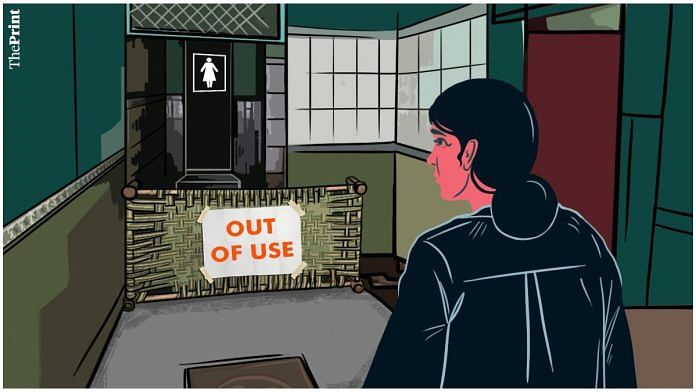New Delhi: Only 6.7 percent of toilets in district courts are women-friendly, according to a report published by the Centre for Research and Planning of the Supreme Court of India.
The report, titled ‘State of the Judiciary: A report on Infrastructure, Budgeting, Human Resources and ICT’, was uploaded on SC’s website on 15 December.
“Eighty percent of the district court complexes have separate ladies’ toilets. However, only 6.7 percent of toilets have a facility for sanitary napkin vending machines and are female-friendly,” the report said.
Asserting that the facility of hygienic toilets for all genders at the workplace is a basic human right, the report noted that court complexes at the district level not only have inadequate washrooms but at times have washrooms that are dysfunctional, with broken doors, and do not have a regular supply of running water.
“Sometimes, washrooms are not attached with the chambers of judicial officers and both male and female judges have to share a common washroom,” the report said.
It added that, even though separate toilets for women are a basic necessity to ensure their safety and dignity, the number of washrooms for them is far less than the number for men in court complexes.
“In district court complexes, usually there are common male and female toilet facilities available for lawyers and litigants. 19.7 percent of the district courts in India do not have separate toilets for females,” said the report.
Moreover, 73.4 percent of district court complexes do not have any sanitary napkin vending machines, it said, adding that in Maharashtra, there are 18 sanitary napkin dispenser machines available in district courts.
Data on the availability of sanitary napkin vending machines was not available for 19.9 percent of district courts.
“To ensure equality, dignity and the right to menstrual health and sanitation facilities to women, it is essential that female toilets in institutions of justice have sanitary napkin vending machines with appropriate menstrual waste disposal options,” the report asserted.
Also Read: What’s stopping India’s judicial infrastructure upgrade? The absence of Centre-state unity
Disabled-friendly infrastructure
The report also had a section assessing the accessibility of courtrooms for persons with disabilities (PwD).
It said that high courts have taken proactive steps to make infrastructure disabled-friendly.
However, for the high courts that are housed in old heritage buildings — like the Allahabad High Court and the main building and PWD (Public Works department) building of the Bombay High Court — any construction or modification to the building is not possible without the permission of the Heritage Committee.
As for the district courts, the report found that they require significant improvement to become disabled-friendly.
For instance, it found that 49.9 percent of district courts did not have ramps, and 74.3 percent didn’t have wheelchairs.
It also revealed that only 5.1 percent of district courts have tactile paving to assist persons with visual impairments in navigating the court building.
As for people with hearing impairments, the report noted that sign-language interpreters, who could be engaged to assist persons with hearing impairment in accessing court proceedings, were available in only 2.8 percent of districts in India.
The analysis, it said, “signifies a critical shortcoming in the judicial infrastructure with respect to accessibility, necessitating concerted attention and action.”
“It is high time that PwD are perceived not from an eye of sympathy but from an empathetic and human rights perspective, and are given equitable opportunities and resources at the workplace,” said the report.
Washrooms for the third gender
On the need for washrooms for the third gender in court complexes, the report noted that district courts generally do not have washrooms for them.
But there are some exceptions, it said.
“In Kerala, washrooms for the third gender are available on a sharing basis with PwDs. In the district courts of Uttarakhand, there are four washrooms for the third gender across the state. In Tamil Nadu, washrooms for third genders are available only in two districts — Chennai and Coimbatore.”
It then asserted, “It is the constitutional duty of the state to protect the right to privacy of the third gender and ensure effective access to justice by providing gender inclusive toilets in every district court premises so that a transgender litigant, lawyer or a judge feels comfortable and safe in using sanitation facilities in a court complex.”
The report looked at judicial infrastructure in detail and noted that only 21.6 percent of district court complexes have waiting areas available for litigants.
(Edited by Richa Mishra)
Also Read: ‘Courts not seen as workplace’—In Hapur, 13 women judges, 200 lawyers have 1 working toilet



